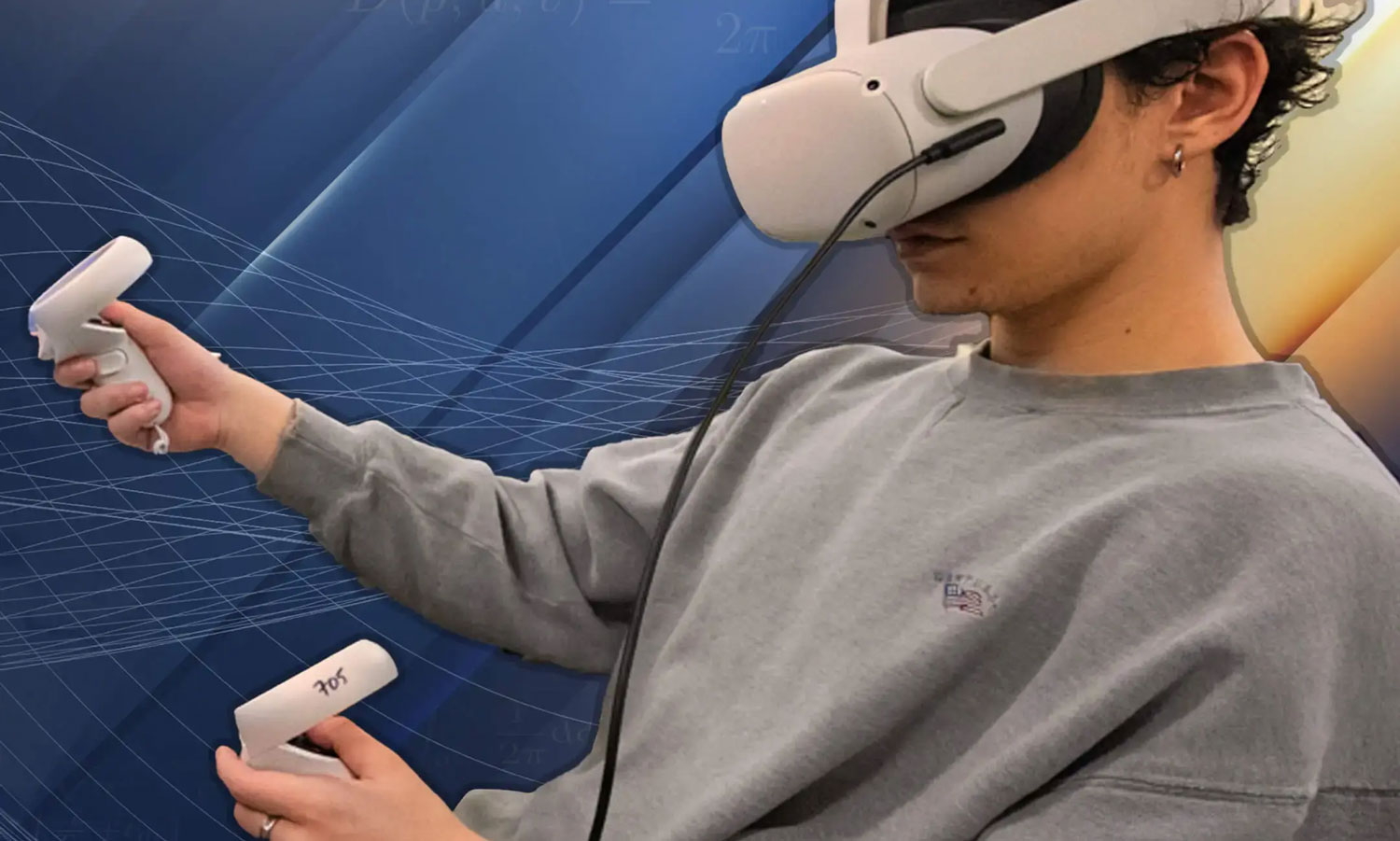At Virginia Commonwealth University’s home to the College of Humanities and Sciences’ Department of Mathematics and Applied Mathematics, a computer lab has transformed into a first-of-its-kind virtual classroom for the spring semester.
It’s out with the 43 desktops in Room 2106 of Grace E. Harris Hall, and in with 30 high-end Alienware gaming systems and Meta Quest virtual reality headsets for students to wear at certain points in their introductory calculus class. The goal: Take a complicated course that students struggle to understand and help them wrap their heads around complex math concepts via virtual objects and 3D environments.
The VR modules will give undergrads visualizations of derivatives, rates of change, critical points and other complex calculus concepts. “The idea is to give concrete, manipulable items to all students to interact with while gaining intuition about these main calculus concepts,” says Rebecca Segal, Ph.D., interim chair and professor in the Department of Mathematics and Applied Mathematics.
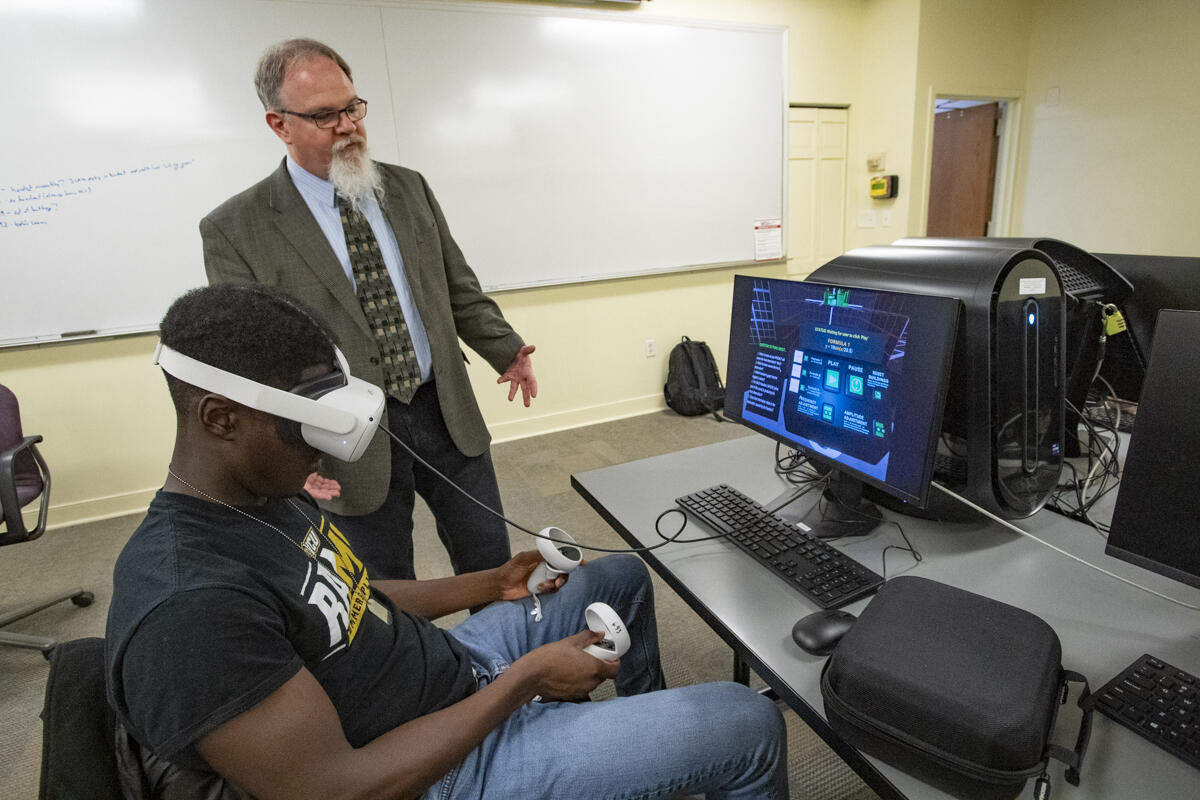
The interactive visualizations are being developed under guidance from Nathaniel Kinsey, Ph.D., associate professor in the VCU College of Engineering’s Department of Electrical and Computer Engineering. He’s built VR simulations that allow engineering students to see, for example, how invisible electromagnetic radio waves, formed by complex algorithms, are shaped. The new VR calculus classroom, with the backing of the Office of the Provost, looks to bring virtual learning to a greater number of students.
“If this calculus class pilot is successful, it allows us to have the ability to rethink what VCU will look like in 20 years,” Kinsey says.
VR virtually everywhere at VCU
Across the academic and medical campuses, instructors, researchers and clinicians have turned to VR for teaching, training and patient care. Beyond a new method of learning, VR offers economic and efficiency benefits by reducing costs of training and anywhere, anytime access to academic lessons. Interactive, virtual applications also give clinicians the ability to treat more patients and make therapies accessible at home, using relatively inexpensive hardware and a web connection.
VR is a broad term but most often involves wearing a ski mask-like headset covering the eyes, allowing the user to become immersed within a 360-degree environment displayed on a screen inside the device. Done properly, the user’s brain is tricked to make it feel as if they are actually within the virtual world — say, walking around a campground, playing in a schoolyard or tearing down a ski slope. The user also holds controllers in their hands to interact with the environment.
(VR’s sibling, “augmented reality” or AR, floats images, animations or text over top of the user’s actual surroundings — viewable through a set of high-tech glasses, such as the Microsoft HoloLens, or on a mobile device.)
‘Breadth’ of VR at VCU
There is nary a school at VCU that VR hasn’t touched.
“As a whole, what VCU has going for us is breadth. There’s a vast array of things people at VCU are using VR for, and that’s what is different from other institutions,” says Nicholas Thomson, Ph.D., a forensic psychologist and associate professor in the College of Humanities and Sciences’ Department of Psychology and School of Medicine’s Department of Surgery. He’s leading a series of studies using VR to provide evidence-based therapies for adolescents at risk of causing violence or having behavioral problems. The attempt is to prevent bullying, violent behaviors and retaliatory violence.
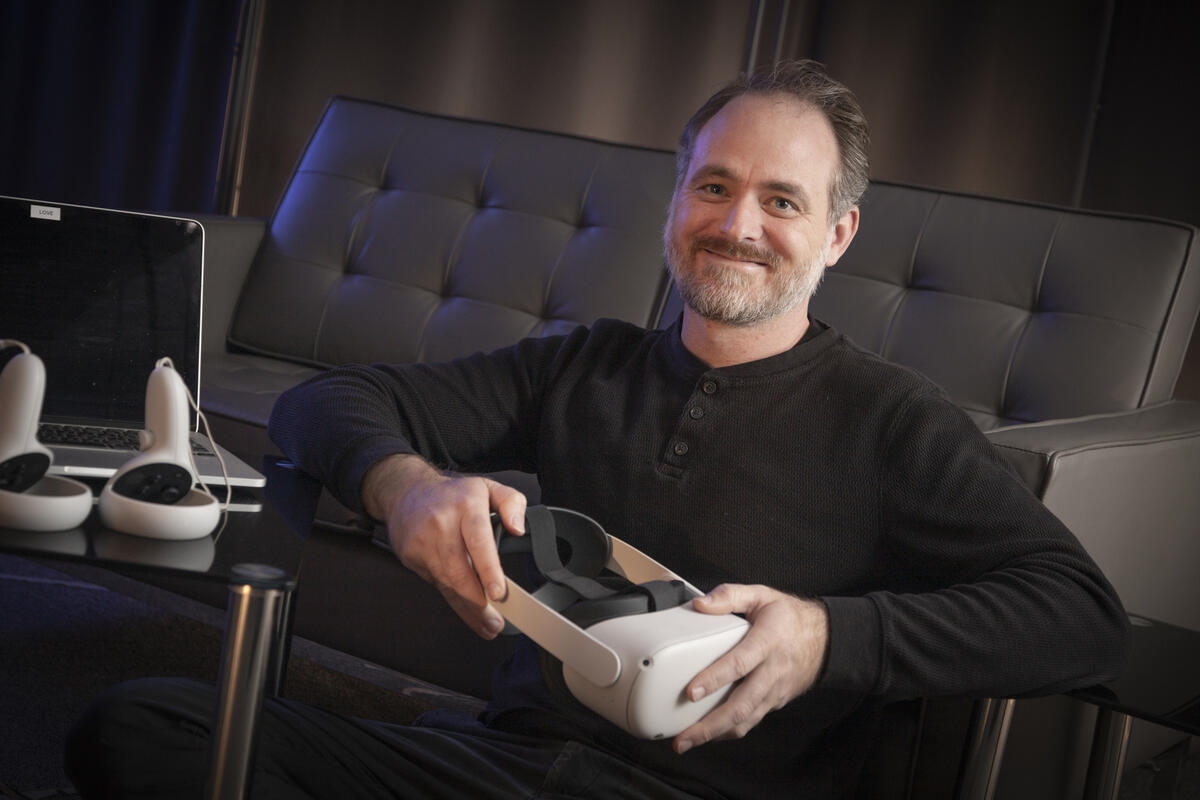
In developing VR applications, there’s trial and error. Some faculty researchers and application developers are further along than others. But all of it contributes to the collective knowledge of the university and a global understanding of how VR can contribute in clinical and academic settings.
“Some of these ideas are not going to work,” says James S. Thomas, Ph.D., a professor in the Department of Physical Therapy in the VCU College of Health Professions, whose National Institutes of Health-funded research focuses on using VR to treat people with motor control issues. “But what, from these ideas, does work? And how do we get what does work to the next generation of VR?”
In teaching and training
For a generation of students who have grown up in a world of screens — undergrad, graduate, postdocs and those in medical residencies — VR offers a visual-first method of learning, helpful for those who struggle in classrooms or with books.
“VR provides a lot of new opportunities in how to reach students and is a richer and quicker way of learning. When you present data in multiple different ways, it enhances students’ ability to uptake information,” Kinsey says. “That’s the general idea of multimedia learning.”
Thomas, Kinsey and VCU School of the Arts’ Semi Ryu lead the VCU Launching Excellence in Virtual Reality (LEVR) Center. LEVR’s ultimate goal is to pool resources across departments, colleges and campuses to advance VR scholarship and development.
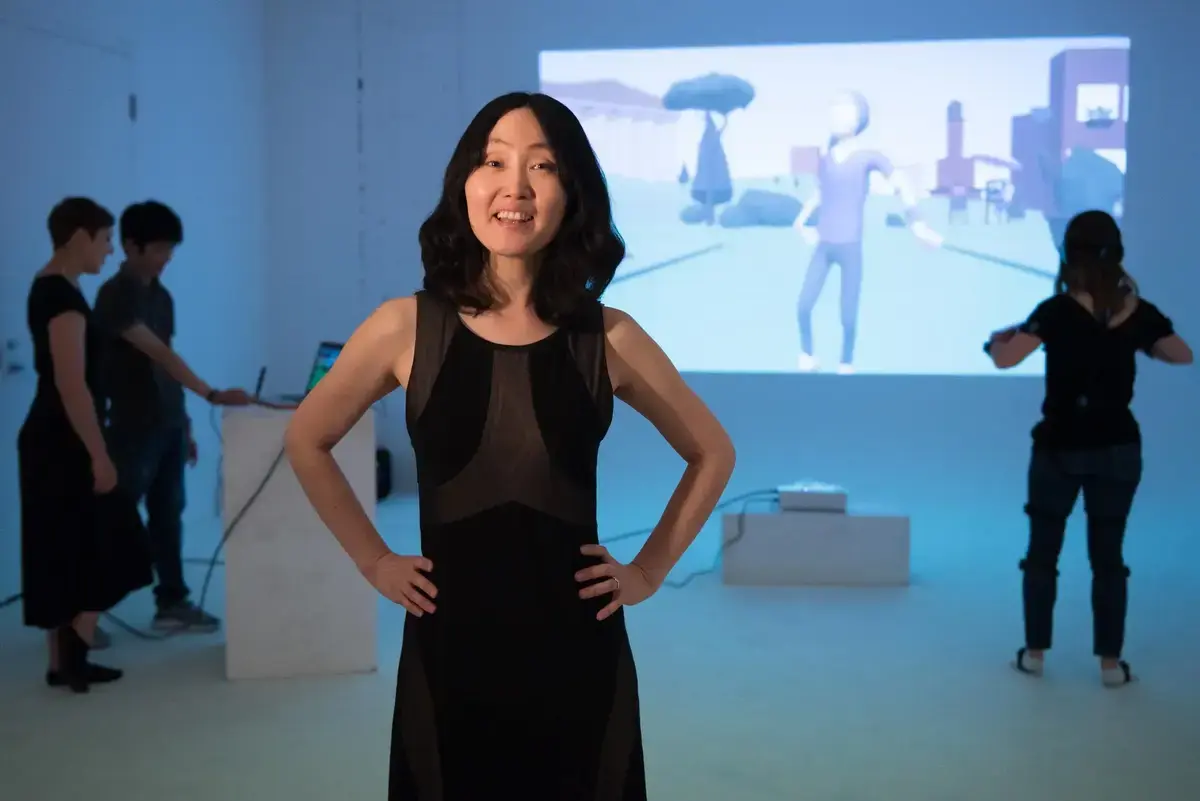
The center received funding from the Office of the Vice President for Research and Innovation’s Breakthroughs Fund to develop a VR yoga application, in collaboration with School of Pharmacy’s Dayanjan S. “Shanaka” Wijesinghe, Ph.D., a Department of Pharmacotherapy and Outcomes Science associate professor (and yoga guru). The idea: Create clinically approved yoga lessons within a VR environment and give them to patients to do at home to treat pain.
Working with the College of Engineering’s Milos Manic, Ph.D., and LEVR, Central Virginia VA Health Care System urogynecologist and VCU adjunct assistant professor Lauren Siff, M.D., wants to replace the expensive and time-intensive training process for surgeons who wish to perform a specific surgery to treat incontinence in women. This VR system uses a virtual, animated pelvis and a haptic controller that provides the surgeon-in-training realistic feedback as they move the on-screen surgical instrument, called a trocar, as the surgical procedure is completed.
Siff hopes the VR app can one day improve or replace existing real-world training methods. It’s more cost-effective than using cadavers, with no travel required. The VR system “will hopefully become a system that allows fellows and training surgeons to say, ‘Put me in coach, I’m ready to play,’” Siff says.
In addition to VR yoga, the School of Pharmacy’s Wijesinghe and his team built an application for physicians that allows them to don the Microsoft HoloLens glasses and, while still viewing their actual surroundings, view virtual, three-dimensional CT and NMR scans.
“If you can see a 3D model on your two-dimensional screen, and you can spin it around in circles [with a mouse], that’s really cool,” says Ken Hopson, who manages VCU Libraries’ The Workshop, a basement enclave filled with gadgets and gizmos to help the VCU community explore emerging technologies. “But when you can walk around your model, while you’re working on it? That’s the bomb.”
To change behaviors
VR can also be used to encourage change in patients’ behaviors. VCU clinicians often partner with engineers to develop apps with a range of therapeutic goals.
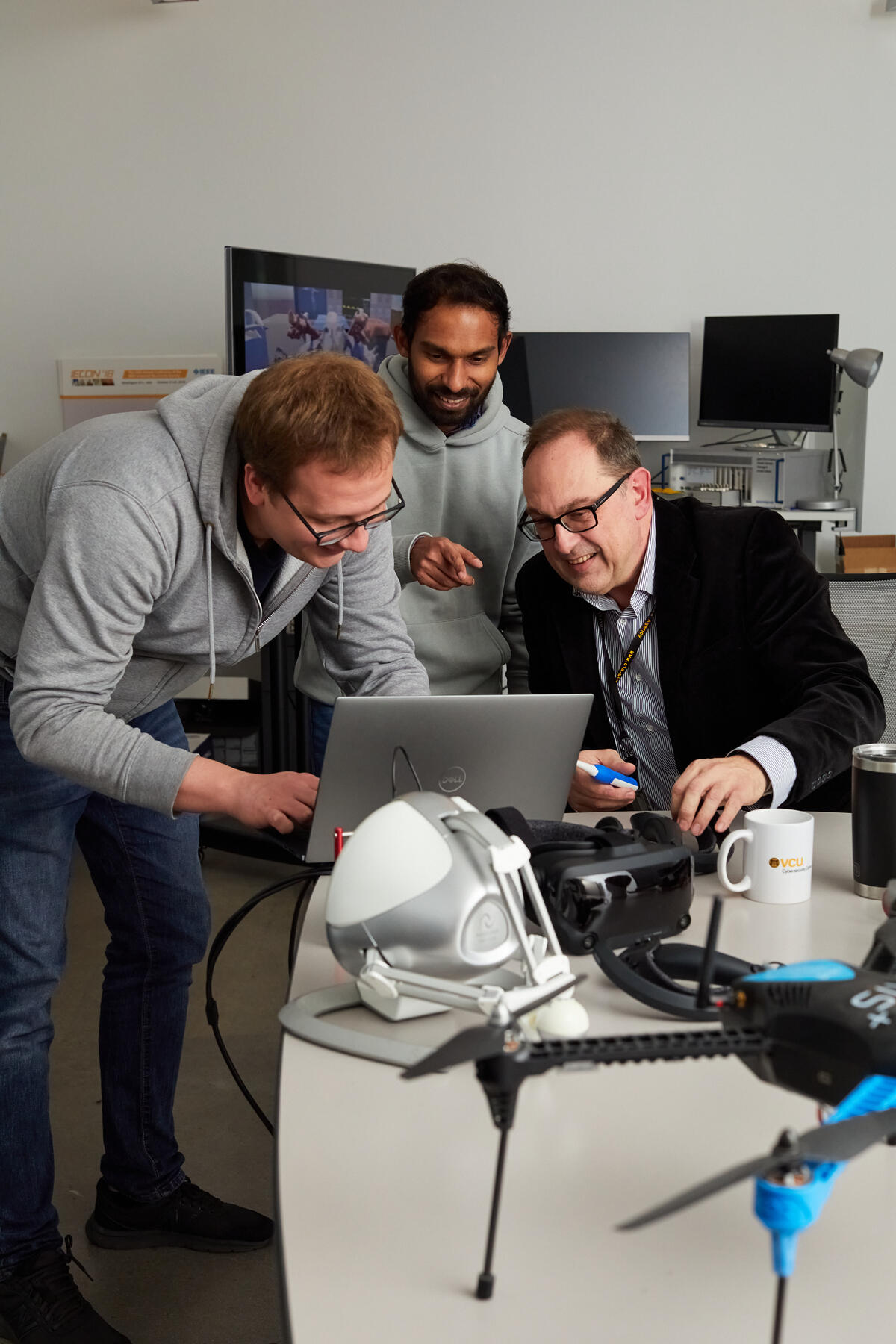
VCU VR pioneer Ryu, a professor of kinetic imaging, has for years led a “virtual bodies” project that gives older adults and cancer patients the ability to see a virtual representation of themselves — as a child or a younger adult — on a projection or inside a headset. The patient, holding a controller or wearing sensors on their body, tells a story and watches their avatar move as they do.
The result: The participant opens up.
At an older or end stage of life, the project has helped adults remember their past and “construct a meaning of their life, which is essential for end-of-life care,” says Ryu, also an associate professor of in the Department of Internal Medicine at the School of Medicine.
Now she’s taking that concept to mental health care for kids. She shares the story of an 8-year-old boy, who rarely spoke to his counselor. Once he used Ryu’s application and could see and move a virtual avatar of himself, “it made him speak,” she says. VR also encourages movement, unlike traditional seated therapy. “He started speaking. He performed. He started talking with his body and gesturing,” Ryu says. “It was unbelievable how [VR] made him comfortable.”
Controlled studies for researchers
VR environments provide researchers with an immersive, controlled environment to do their research.
Hayley Cleary, associate professor of criminal justice at the L. Douglas Wilder School of Government and Public Affairs, is using VR to explore the slippery slope between permissible police interrogation techniques and coercion to elicit a confession. Research shows youths’ developmental immaturity makes them vulnerable to forcible persuasion and more likely to provide false confessions to escape police pressure, she says.
She’s created a VR environment that places a young person in an immersive interrogation scenario in which a detective questions them using various techniques. Participants report their perceptions of custody and coercion, and researchers collect their physiological data.
“VR enables us to simulate real-world interrogations while also retaining experimental control and ensuring participant safety,” says Cleary, whose research was supported by the VCU Quest Fund with a goal of informing law and policy, particularly for suspects of color who may experience heightened disadvantage in interrogations. “It’s the best of both worlds from a research perspective.”
Thomas and his team are building a series of virtual games (clinicians call them “interventions”) for patients with movement disorders. Wearing a headset, the patient can go virtual fishing or swipe at volleyballs launched at different speeds and trajectories. As director of the Motor Control Lab at VCU, Thomas’ hope is VR can help those with trunk control impairments caused by orthopedic or neurological conditions such as Parkinson’s disease to get moving. “And hopefully, when you take the headset off, you’re moving even better,” he says.
Zina Trost, Ph.D., an associate professor in the Department of Physical Medicine and Rehabilitation, uses VR to treat neuropathic pain in individuals with spinal cord injuries. Wearing a VR headset, paraplegics who have lost use of their real-world legs gain the ability to walk in a virtual environment — a method of both staying active and improving their chronic pain. Her hope is for the platform to become a telehealth tool for patients that can be monitored by offsite clinicians. Trost’s multisite clinical trial is funded by the Department of Defense.
Local visual-effects pro Mark Lambert and Jarrod Reisweber, Psy.D., an assistant professor in the Department of Psychology, have developed The Retreat, a VR program for individuals in recovery for substance use disorder. In it, users visit a campground loaded with different lessons, meditations and games to complement their in-person cognitive behavioral therapy sessions. Early testing at the VA, where Reisweber practices, have shown positive results.
Looking ahead
But can behavior changes last after the screen is gone and the headset is put away? It’s a great unknown, Thomas says. Do skills developed by trainees using Siff’s VR surgical trainer translate into reduced complications or improved surgical outcomes? Does playing VR dodgeball improve the ability to move with less pain in the real world?
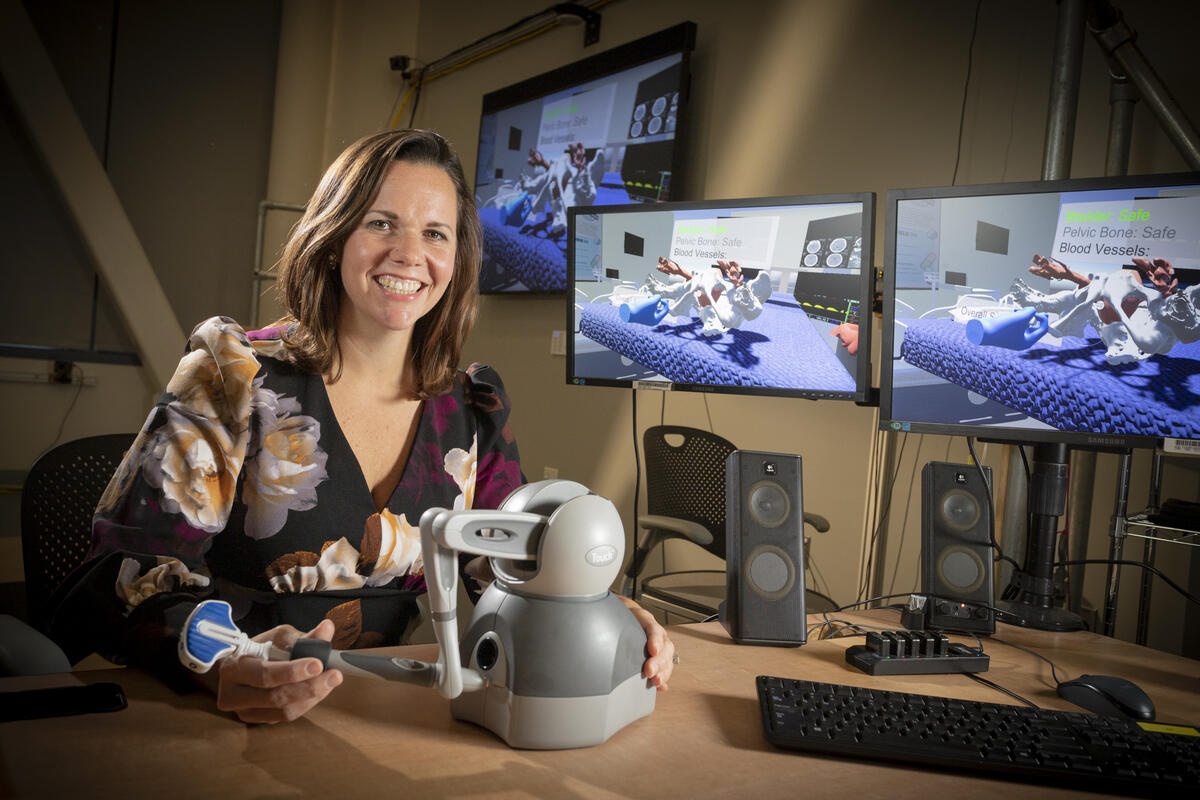
“These are the questions that need to be addressed by rigorous scholarship, and VCU is extremely well-positioned for that task,” says Thomas, who is nearing completion of his VR dodgeball Phase II clinical trial. He encourages researchers to take their time and ensure their applications are not using VR just for the sake of it.
“My biggest fear is that people will race ahead to build an application before completing the research, and all of the sudden you’ll have a lot of bad applications that don’t really do anything and VR gets a bad name,” Thomas says. “It’s a wonderfully powerful tool. Right now, for researchers, it has great potential as a clinical tool with a home for very specific applications.”
Building VR apps takes time and feedback from clinicians and patients, which ultimately translates into reworking software code or making hardware adjustments. The end goal is to make the VR experience as real and interesting as possible.
“The more I can get you to engage in the target behavior, the more I’m going to get remodeling at the neural level, and get those outcomes we want,” Thomas says. “That’s that Holy Grail of VR.”
Want to get involved with VR at VCU?
- For students and others in the VCU community interested in VR projects, contact The Workshop and Ken Hopson.
- For VCU clinicians and researchers who want to explore VR work in the health and academic campuses, learn more about the LEVR Center.
